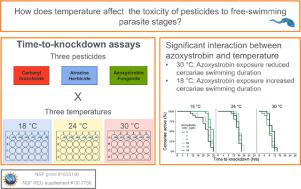Aquatic Toxicology ( IF 4.1 ) Pub Date : 2022-01-24 , DOI: 10.1016/j.aquatox.2022.106102 Logan S Billet 1 , Alice Belskis 2 , Jason T Hoverman 1

|
Global climate change is predicted to have significant impacts on ecological interactions such as host-parasite relationships. Increased temperatures may also interact with other anthropogenic stressors, such as chemical contaminants, to exacerbate or reduce parasite transmission. However, studies on the effects of pesticides on non-target species are typically conducted at one standard temperature, despite the toxicity of many agrochemicals being temperature-dependent. Furthermore, most studies assessing the effects of temperature on pesticide toxicity have been conducted on host organisms, limiting our understanding of how temperature affects the toxicity of pesticides to free-living parasite stages as they move through the environment in search of a host. Using the free-swimming cercariae stage of the trematode Echinostoma trivolvis, we examined how the toxicities of three different pesticides (a carbamate insecticide, strobilurin fungicide, and triazine herbicide) vary by temperature by monitoring cercarial swimming activity over time. Our three main findings were: 1) a strong main effect of temperature across all pesticide trials – higher temperatures caused cercariae to cease swimming activity earlier, likely due to an increased rate of energy expenditure, 2) atrazine, azoxystrobin, and carbaryl were directly toxic to cercariae to some degree, but not in a predictable dose-dependent manner, and 3) the temperature at which pesticide exposure occurs could affect its toxicity to cercariae. The interaction between pesticide and temperature was most evident in the azoxystrobin exposure; azoxystrobin caused cercariae to cease swimming activity earlier at 30 °C but caused cercariae to maintain swimming activity longer at 18 °C relative to their respective pesticide-free control treatments. These findings highlight the importance of conducting toxicity assays at multiple temperatures and suggest that the combined effects of pesticides and temperature on host-parasite interactions may be difficult to generalize.
中文翻译:

温度影响农药对三轮棘吸虫尾蚴的毒性
预计全球气候变化将对生态相互作用产生重大影响,例如宿主-寄生虫关系。温度升高还可能与其他人为压力源(例如化学污染物)相互作用,从而加剧或减少寄生虫传播。然而,尽管许多农用化学品的毒性与温度有关,但有关农药对非目标物种影响的研究通常在一个标准温度下进行。此外,大多数评估温度对杀虫剂毒性影响的研究都是在宿主生物上进行的,这限制了我们对温度如何影响杀虫剂毒性的理解,因为它们在环境中寻找宿主时是自由生活的寄生虫阶段。使用吸虫的自由游动尾蚴阶段三轮棘口线虫,我们通过监测尾蚴游泳活动随时间的变化,研究了三种不同杀虫剂(氨基甲酸酯类杀虫剂、甲氧基丙烯酸酯类杀真菌剂和三嗪类除草剂)的毒性如何随温度变化。我们的三个主要发现是:1) 在所有农药试验中,温度的主要影响很大——较高的温度导致尾蚴提前停止游泳活动,可能是由于能量消耗率增加,2) 阿特拉津、嘧菌酯和西维因直接有毒对尾蚴有一定程度的影响,但不是以可预测的剂量依赖性方式,以及 3) 农药暴露发生的温度可能会影响其对尾蚴的毒性。农药与温度之间的相互作用在嘧菌酯暴露中最为明显;嘧菌酯导致尾蚴在 30°C 时更早停止游泳活动,但相对于它们各自的无农药对照处理,导致尾蚴在 18°C 时保持游泳活动的时间更长。这些发现强调了在多个温度下进行毒性测定的重要性,并表明农药和温度对宿主-寄生虫相互作用的综合影响可能难以概括。











































 京公网安备 11010802027423号
京公网安备 11010802027423号